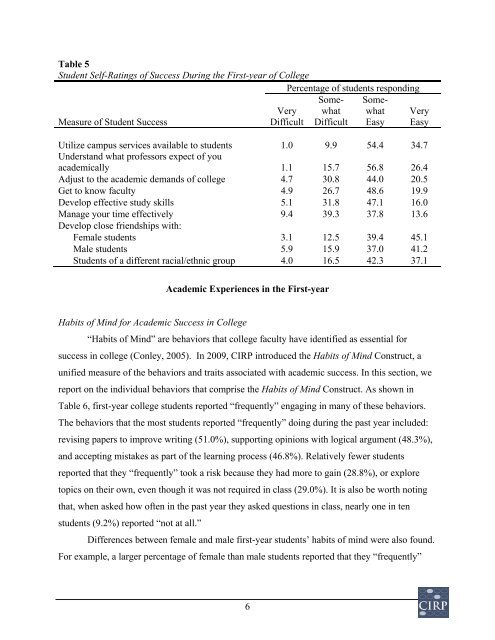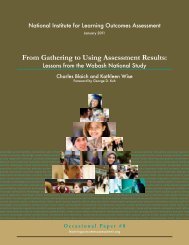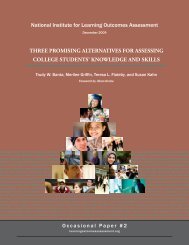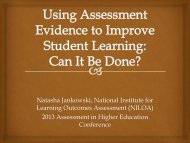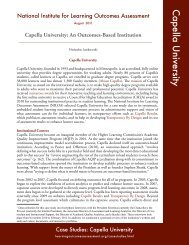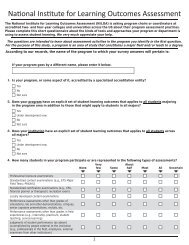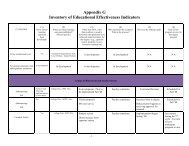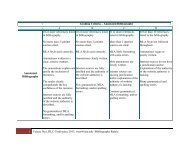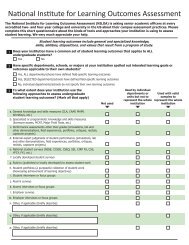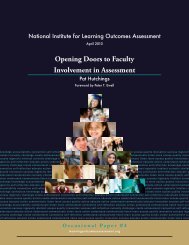Findings from the 2009 Administration of the Your First College Year ...
Findings from the 2009 Administration of the Your First College Year ...
Findings from the 2009 Administration of the Your First College Year ...
Create successful ePaper yourself
Turn your PDF publications into a flip-book with our unique Google optimized e-Paper software.
Table 5Student Self-Ratings <strong>of</strong> Success During <strong>the</strong> <strong>First</strong>-year <strong>of</strong> <strong>College</strong>Measure <strong>of</strong> Student SuccessPercentage <strong>of</strong> students respondingSomewhawhatSome-Difficult EasyVeryDifficultVeryEasyUtilize campus services available to students 1.0 9.9 54.4 34.7Understand what pr<strong>of</strong>essors expect <strong>of</strong> youacademically 1.1 15.7 56.8 26.4Adjust to <strong>the</strong> academic demands <strong>of</strong> college 4.7 30.8 44.0 20.5Get to know faculty 4.9 26.7 48.6 19.9Develop effective study skills 5.1 31.8 47.1 16.0Manage your time effectively 9.4 39.3 37.8 13.6Develop close friendships with:Female students 3.1 12.5 39.4 45.1Male students 5.9 15.9 37.0 41.2Students <strong>of</strong> a different racial/ethnic group 4.0 16.5 42.3 37.1Academic Experiences in <strong>the</strong> <strong>First</strong>-yearHabits <strong>of</strong> Mind for Academic Success in <strong>College</strong>“Habits <strong>of</strong> Mind” are behaviors that college faculty have identified as essential forsuccess in college (Conley, 2005). In <strong>2009</strong>, CIRP introduced <strong>the</strong> Habits <strong>of</strong> Mind Construct, aunified measure <strong>of</strong> <strong>the</strong> behaviors and traits associated with academic success. In this section, wereport on <strong>the</strong> individual behaviors that comprise <strong>the</strong> Habits <strong>of</strong> Mind Construct. As shown inTable 6, first-year college students reported “frequently” engaging in many <strong>of</strong> <strong>the</strong>se behaviors.The behaviors that <strong>the</strong> most students reported “frequently” doing during <strong>the</strong> past year included:revising papers to improve writing (51.0%), supporting opinions with logical argument (48.3%),and accepting mistakes as part <strong>of</strong> <strong>the</strong> learning process (46.8%). Relatively fewer studentsreported that <strong>the</strong>y “frequently” took a risk because <strong>the</strong>y had more to gain (28.8%), or exploretopics on <strong>the</strong>ir own, even though it was not required in class (29.0%). It is also be worth notingthat, when asked how <strong>of</strong>ten in <strong>the</strong> past year <strong>the</strong>y asked questions in class, nearly one in tenstudents (9.2%) reported “not at all.”Differences between female and male first-year students’ habits <strong>of</strong> mind were also found.For example, a larger percentage <strong>of</strong> female than male students reported that <strong>the</strong>y “frequently”6


